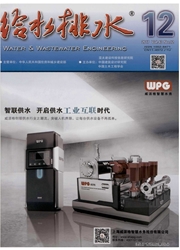

 中文摘要:
中文摘要:
考察厌氧-缺氧SBR(A^2SBR)工艺中主导生化反应过程及聚磷污泥的特性,为反硝化除磷脱氮工艺的应用提供运行控制参数。在稳定运行的A^2SBR系统进水中分别投加NaAc和葡萄糖作为碳源,进行对比试验。结果表明,进水中的有机物越容易降解,反硝化除磷菌(DPB)厌氧释磷速率越快,后续的缺氧吸磷效果也越好。同时通过静态试验考察了不同浓度CODCr、NO3^- -N、不同类型电子受体对DPB反硝化除磷效果的影响。结果表明,进水CODCr,为300mg/L、NO3^- -N为60mg/L时反硝化除磷效果最佳,同时缺氧段瞬时投加NO3^- -N利于驯化DPB对NO2^- -N的适应性,可以实现DPB利用不同类型的电子受体进行吸磷作用。
 英文摘要:
英文摘要:
To supply valuable operation parameters for the new denitrifying phosphorus removal technique, it is necessary to study the dominant biological reaction and the characteristics of denitrifying phosphorus removal bacteria (DPB) in the A^2SBR process. NaAc and glucose were added into the A^2SBR system in stable status to carry out contrast test, respectively. The results showed that the easier the organic matters were degraded, the sooner phosphorus was released by DPB in anaerobic phase and the better phosphorus uptake efficiency was obtained. Simultaneously, the influence of different concentrations of CODcr and NO3^- -N and different of electron acceptors on the denitrifying phosphorus removal efficiency were investigated by parallel batch tests. The results showed that when the influent concentration of CODCr and NO3^- -N was 300 mg/L and 60 mg/L respectively, the optimum removal efficiency was obtained. In anoxic phase, instantaneous addition of NO3^- -N could domesticate DPB with NO2^- -N and achieve that DPB was capable of utilizing different type of electron acceptors for phosphorus uptake.
 同期刊论文项目
同期刊论文项目
 同项目期刊论文
同项目期刊论文
 Application of bioaugmentation in the rapid start-up and stable operation of biological processes fo
Application of bioaugmentation in the rapid start-up and stable operation of biological processes fo Effect of Aridification on the Replacement of Zonic Species, Stipa baicalensis Roshev., by Azonic Sp
Effect of Aridification on the Replacement of Zonic Species, Stipa baicalensis Roshev., by Azonic Sp Start-up of a two-stage bioaugmented anoxic-oxic (A/O) biofilm process treating petrochemical wastew
Start-up of a two-stage bioaugmented anoxic-oxic (A/O) biofilm process treating petrochemical wastew 期刊信息
期刊信息
